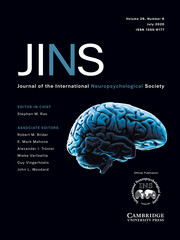Regular Research
False Memories: The Other Side of Forgetting
-
- Published online by Cambridge University Press:
- 28 February 2020, pp. 545-556
-
- Article
- Export citation
Atypical Visual Scan Path Affects Remembering in ADHD
-
- Published online by Cambridge University Press:
- 12 December 2019, pp. 557-566
-
- Article
- Export citation
The NIH Toolbox: Overview of Development for Use with Hispanic Populations
-
- Published online by Cambridge University Press:
- 17 February 2020, pp. 567-575
-
- Article
- Export citation
The Uniform Dataset 3.0 Neuropsychological Battery: Factor Structure, Invariance Testing, and Demographically Adjusted Factor Score Calculation
-
- Published online by Cambridge University Press:
- 17 February 2020, pp. 576-586
-
- Article
- Export citation
Neuropsychological Alterations in Narcolepsy with Cataplexy and the Expression of Cognitive Deficits
-
- Published online by Cambridge University Press:
- 12 December 2019, pp. 587-595
-
- Article
- Export citation
The Relation Between Personality and Biomarkers in Sensitivity and Conversion to Alzheimer-Type Dementia
-
- Published online by Cambridge University Press:
- 11 December 2019, pp. 596-606
-
- Article
- Export citation
Attention/Working Memory, Learning and Memory in Adult Cameroonians: Normative Data, Effects of HIV Infection and Viral Genotype
-
- Published online by Cambridge University Press:
- 18 February 2020, pp. 607-623
-
- Article
- Export citation
Brief Communication
Operationalizing Impaired Performance in Neuropsychological Assessment: A Comparison of the Use of Published Versus Sample-Based Normative Data for the Prediction of Dementia
-
- Published online by Cambridge University Press:
- 11 December 2019, pp. 624-631
-
- Article
- Export citation
Front Cover (OFC, IFC) and matter
INS volume 26 issue 6 Cover and Front matter
-
- Published online by Cambridge University Press:
- 25 June 2020, pp. f1-f2
-
- Article
-
- You have access
- Export citation
Back Cover (OBC, IBC) and matter
INS volume 26 issue 6 Cover and Back matter
-
- Published online by Cambridge University Press:
- 25 June 2020, pp. b1-b2
-
- Article
-
- You have access
- Export citation



